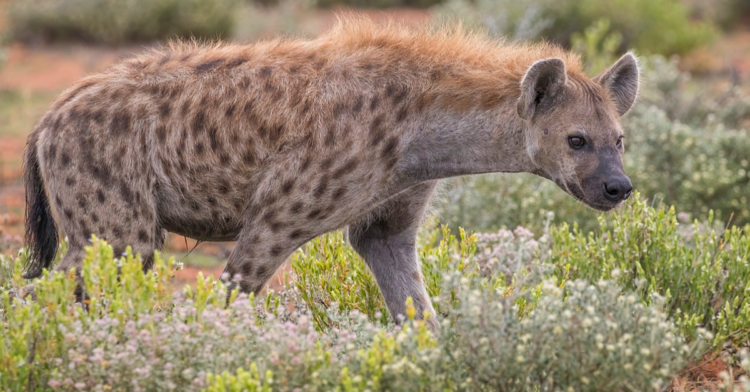When we think about it, it’s a little strange that we tend to assign positive and negative reputations to animals. After all, no matter how we classify or perceive them, they’re really just operating on instinct and doing what seems necessary to survive.
Nonetheless, it’s something that humanity just can’t seem to stop itself from doing as even our common language tends to show much we favor certain animals over others. I was going to say that we lionize some of them, but that term is a perfect example of that phenomenon in action.
But while it’s not terribly hard to appreciate how bugs, snakes, and rats get these unsavory reputations since they are everyday nuisances for a lot of people throughout the world, it’s particularly puzzling that hyenas get lumped into a similar category.
And it’s not only weird because most of us aren’t likely to meet too many hyenas in our lives, but also because our common perceptions of them manage to get just about everything wrong.
Although many of us can point to _The Lion King_ as the engine of hyenas’ bad reputation, that film was drawing on a much richer history of hyena hate than you might expect.

As National Geographic reported , this seemed to start at least as far back as Aristotle, who described them as “exceedingly fond of putrefied flesh.”
Pliny the Elder of ancient Rome was apparently convinced they could magically paralyze other animals, while revered U.S. president Theodore Roosevelt characterized them as “singular mixture of abject cowardice and the utmost ferocity.”
But while Roosevelt had many admirable qualities, it seems that his ability to judge the character of hyenas — particularly spotted hyenas — wasn’t one of them.
But since Disney got the ball rolling in this department for many of us, let’s start with one of the big myths about hyenas that we see in _The Lion King_.

Namely, that they’re stupid.
According to National Geographic , hyenas know to adjust the size of their groups according to prey availability as they move in clans of around 10 in desert regions with scarce food sources but can gather in groups of up to 120 in more resource-rich parts of Africa like the Ngorongoro Conservation Area in Tanzania and Kenya’s Masai Mara National Reserve.
As Ingrid Wiesel of the Brown Hyena Research Project pointed out, “You couldn’t maintain all these social bonds if you weren’t intelligent.”
The BBC also highlighted research showing this is particularly true in the case of spotted hyenas, who have larger brains than other hyenas and have particularly well-developed forebrains, which are associated with complex decision-making.
Furthermore, that ability to coordinate in groups of up to 120 does a lot to show how social hyenas are.

And as Arjun Dheer of Leibniz Institute for Zoo and Wildlife Research told National Geographic , those clans tend to be led by an alpha but also include a system of lower rankings for the other adults and young in the clans.
And when we return to spotted hyenas in particular, the BBC reported that the alpha member of these clans is often female and commands the first pick of the food so she can reproduce more efficiently and with a greater success rate than others within her clan.
Ultimately, Dheer described spotted hyenas as “the most socially complex carnivores in the world.”
And while we’re on the subject of the spotted hyenas carnivorous eating habits, it’s worth noting that their perception as scavengers who mostly eat carrion is very misleading.

According to the BBC , it is true that brown and striped hyenas have a significant amount of carrion in their diets but Kay Holekamp of Michigan State University said that no spotted hyena population anywhere in Africa hunts less than 50% of their own food.
And considering that even one is capable of subduing a wildebeest four times its size, that’s not a terribly surprising statistic.
Contrary to what their respective reputations would suggest, you’re actually more likely to see a lion scavenge from the body of spotted hyena than vice versa.
Finally, we come to the hyenas curiously “evil” reputation, which reached even supernatural proportions for figures like Pliny the Elder.

Since spotted hyenas in particular have similar hunting practices to more glorified carnivores, it seems that we can attribute this aspect of their reputation to their trademark “laugh.”
But while it may sound duplicitous or sadistic to those who would characterize the animal this way, National Geographic reported that it’s not even a laugh at all.
It’s also not characteristic of most hyenas, who typically whoop in other ways.

You’re likely to hear these whoops when they need to call for backup, demonstrate their desirability to their mates, or simply tell each other where they are.
It turns out that the “laugh” is only found among spotted hyenas and it’s actually a sign that a lower-ranking member of a clan is stressed or upset. The fact that it sounds like a laugh is purely coincidental.
So while it’s probably a good idea to treat a spotted hyena with the same caution that we would a lion or a tiger, one could also argue that it deserves a similar majestic reputation to those animals.
h/t: National Geographic , BBC

















































